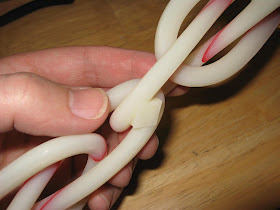
I've been admiring the data for Chylld's
Vica Illusion Sculpture but I've been reluctant to build it because I would want to build it in a horizontal orientation, and I admit I'm unsure about arranging peeling cuts. On the one hand I could play safe by arranging peeling cuts to isolate each part of the sculpture, but so many isolated zones could result in a lot of unnecessary work to clean away the supports. Did I really want to build a throwaway model just to determine how many peeling cuts are necessary?
There was a small empty volume in the build envelope for an unrelated model, so I decided to build a scaled-down version of the Vica sculpture just to test it. This is essentially a "free" model so I ambitiously tried the simplest peeling cut layout I could think of, dividing the model into only 4 zones, of which 2 were exterior regions that would be peeled away normally.

The 2 exterior regions peeled away effortlessly while cleaning up the principal model, leaving the Vica sculpture embedded in a small cocoon of its own. The top surface shows the outlines of the remaining two zones that need to be peeled away.

It went surprisingly well, so I'm glad I aimed for such simple layout. The only issue was a region near the center of the model, where a handful of layers needed to be peeled from the topside of one part of the sculpture while the same layer extended to the underside of the other part of the sculpture. A few strips of material had to be loosened and tucked (or pulled) through an opening in the sculpture.

That issue could be remedied on future builds by adding an additional peeling cut (arrow) to separate the support layers near the middle of the model. It doesn't need to run the full height of the model because the problem only affected the innermost layers.

Despite that one peeling problem, and the model's thin structure, the model held together very well because the last region to be peeled formed a nice keel-shaped backbone that reinforced the model while I was clearing the exterior sections. This material peeled away effortlessly because it wasn't entangled with the rest of the model.

So the downscaled model emerged intact and attractive. Even at this reduced size the walls were thicker than 3mm, which puts the model within the SD300's optimal safe-build range. There's exactly 1 layer of red material through the model's exact center, so the red marks indicate where the sculpture's structure passes through its midpoint; a cool bonus feature!






























